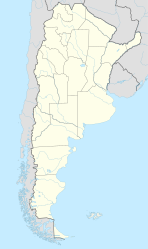Jujuy
| San Salvador de Jujuy | ||
|---|---|---|
| City | ||

(From top to bottom; from left to right) View of the city; Monument to Belgrano; Cathedral of St. Francis; Downtown and Patio of the Cathedral Church
|
||
|
||
| Location of San Salvador de Jujuy in Argentina | ||
| Coordinates: 24°11′S 65°18′W / 24.183°S 65.300°WCoordinates: 24°11′S 65°18′W / 24.183°S 65.300°W | ||
| Country | Argentina | |
| Province | Jujuy | |
| Department | Doctor Manuel Belgrano | |
| Founded | April 19, 1593 | |
| Government | ||
| • Intendant | Raúl Jorge (UCR) | |
| Area | ||
| • Total | 19 km2 (7 sq mi) | |
| Elevation | 1,259 m (4,131 ft) | |
| Population (2001) | ||
| • Total | 237,751 | |
| • Density | 13,000/km2 (32,000/sq mi) | |
| Demonym(s) | Jujeño | |
| Time zone | ART (UTC−3) | |
| CPA base | Y4600 | |
| Dialing code | +54 388 | |
| Website | Official website | |
San Salvador de Jujuy (Spanish pronunciation: [san salβaˈðor ðe xuˈxui]), commonly known as Jujuy and locally often referred to as San Salvador, is the capital city of Jujuy Province in northwest Argentina. Also, it is the seat of the Doctor Manuel Belgrano Department. It lies near the southern end of the Humahuaca Canyon where wooded hills meet the lowlands.
Its population at the 2001 census [INDEC] was 237,751 inhabitants. If its suburbs are included, this figure rises to around 300,000. The current mayor is Raúl Jorge.
The city lies on National Route 9 that connects La Quiaca 289 km (180 mi) with Salta 120 km (75 mi), and it is 1,525 km (948 mi) from Buenos Aires. Tourist destinations not far from the city are Tilcara 84 km (52 mi), Humahuaca 126 km (78 mi), and the Calilegua National Park 111 km (69 mi).
Jujuy is located near the Andes, at the junction of the Xibi Xibi River and the Río Grande de Jujuy, 1,238 meters above sea level. The weather is humid during the summer and dry and cold during the winter. Temperatures vary widely between day and night.
The city is the provincial government, financial and cultural centre. Most administrative offices related to economic activities that take place in other parts of the province are located here; these activities include petroleum extraction and pre-processing, sugarcane and sugar industry (Ledesma), tobacco (El Carmen, 10 km south), steel (in nearby Villa Palpalá), citrus, and fruit and vegetable production for local consumption.
...
Wikipedia


